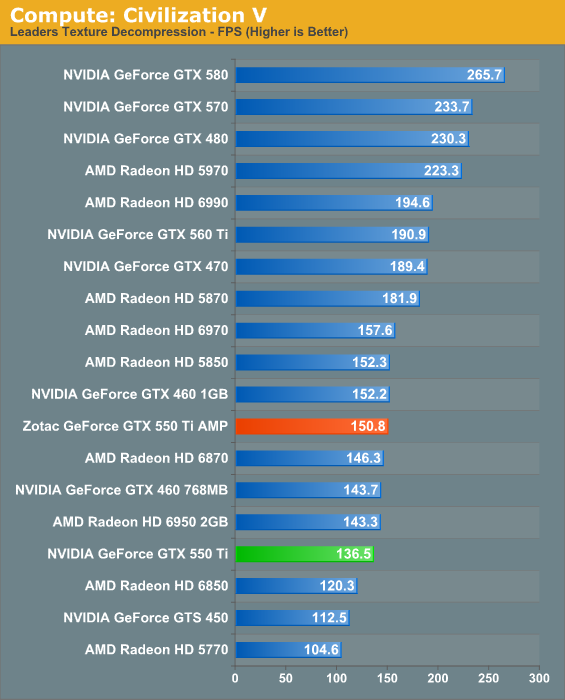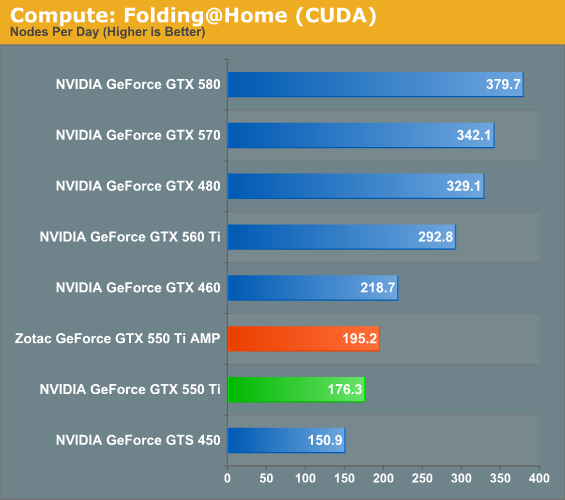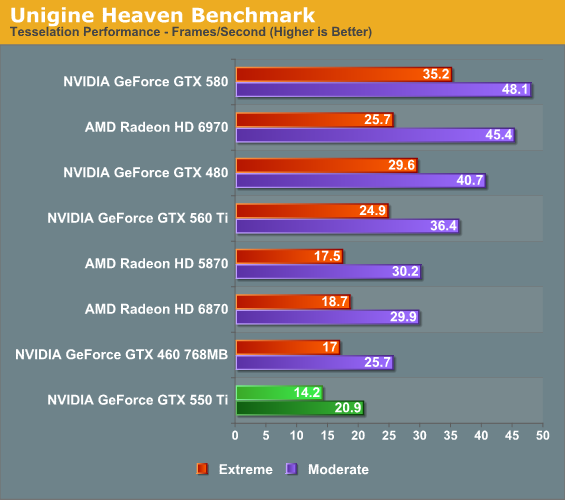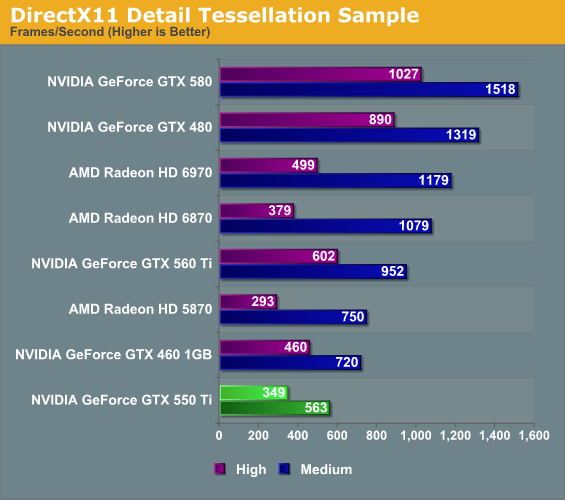NVIDIA's GeForce GTX 550 Ti: Coming Up Short At $150
by Ryan Smith on March 15, 2011 9:00 AM ESTCompute & Tessellation
Moving on from our look at gaming performance, we have our customary look at compute performance, bundled with a look at theoretical tessellation performance.
Our first compute benchmark comes from Civilization V, which uses DirectCompute to decompress textures on the fly. Civ V includes a sub-benchmark that exclusively tests the speed of their texture decompression algorithm by repeatedly decompressing the textures required for one of the game’s leader scenes.

Unlike our gaming benchmarks, Civ V’s compute performance strongly favors NVIDIA’s Fermi family here, giving the GTX 550 a very strong showing. At 136fps it’s competitive with the much more expensive 6950 and even comes quite close to the GTX 460 768MB. The 6850 and 5770 meanwhile fall well behind.
What’s quite interesting is that with a bit more gas, the Zotac AMP really climbs up the charts. At 150fps it’s tailing the GTX 460 1GB and even AMD’s single-GPU king, the 6970. And ultimately while this benchmark is compute bound, it’s also memory bound at least part of the time, which is why the GTX 550 outperforms the GTS 450 by 21%.
Our second GPU compute benchmark is SmallLuxGPU, the GPU ray tracing branch of the open source LuxRender renderer. While it’s still in beta, SmallLuxGPU recently hit a milestone by implementing a complete ray tracing engine in OpenCL, allowing them to fully offload the process to the GPU. It’s this ray tracing engine we’re testing.

SmallLuxGPU also gives NVIDIA a solid standing here, however not quite as much as with Civ V. The GTX 550 beats the 5770 and even pulls ahead of the 6850 here. The benefit from the memory bandwidth increase is minimal however, leading to a lower 15% gain versus the GTS 450, and a larger 25% gap versus the GTX 460.
Our final compute benchmark is a Folding @ Home benchmark. Given NVIDIA’s focus on compute for Fermi, cards such as the GTX 560 Ti can be particularly interesting for distributed computing enthusiasts, who are usually looking for a compute card first and a gaming card second.

We do not normally classify Folding@Home to be very memory bandwidth sensitive on GPUs, which makes our results here more interesting than we expected. A 17% gain over the GTS 450 is in-line with the core clock increase, but achieving 81% of the GTX 460 is no small feat. With the AMP’s overclock, the card closes to within 10% of the GTX 460.
At the other end of the spectrum from GPU computing performance is GPU tessellation performance, used exclusively for graphical purposes. With Fermi NVIDIA bet heavily on tessellation, and as a result they do very well at very high tessellation factors. With 1 GPCs the GTX 560 Ti can only retire 1 triangle/clock however, which nullifies much of the architectural advantage on paper.

Even with extreme levels of tessellation, the lower geometry throughput of the GTX 550 keeps a lid on performance. It’s consistently around 80% of the performance of the GTX 460, however the hit for using extreme tessellation ultimately is greater here than on NVIDIA cards with more geometry throughput. As NVIDIA likes to note it has quite a bit more geometry throughput than older generation cards, but tying geometry performance to the number of SMs means parity between high and low-end cards is lost.

The DX11 Detail Tessellation sample reinforces those findings. NVIDIA does keep up their solid scaling from medium to high tessellation versus AMD though., including a very surprising score versus the 5870 and 6870 at high tessellation.










79 Comments
View All Comments
Marlin1975 - Tuesday, March 15, 2011 - link
But over priced.If this was in the $100 area it be a much better buy. But the cheaper 460 is better right now.
Also you have the 450 in yoru graph as a 256bit bandwidth, not the 128bit it is.
vol7ron - Tuesday, March 15, 2011 - link
I'm not usually an advocate of OCing gpus, but I'm curious how much more performance could be achieved. We know there's some room in the memory, how much more can the gpu/shaders really extract? While Zotac OCs, they normally don't max it out on air cooling, so a little testing would be nice :)slickr - Tuesday, March 15, 2011 - link
Its a crap card.Its about $50 overpriced, its worse in consumption, noise and coolness than Nvidia's own 1 year old GTS 450.
So how can this be a good card? For the same price I can get a GTX 460 768mb that performs 20% faster and I can get cooler, quieter and less power draw card for $50 less in the 5770 and still get the same performance.
If you ask me this card is a rip off for consumers who don't know anything about graphic cards.
Aircraft123 - Tuesday, March 15, 2011 - link
I really don't understand why nVidia is so concerned with these lower performing cards.Their own cards from TWO GENERATIONS AGO perform better then this "new" card.
I have a GTX275 it will perform equivalent or better than this new card and you can find it on a particular auction site for ~$100.
The only thing missing from my 275, is directX 11. Which unless you get a 470 or greater the card isn't powerful enough to run any dx11 stuff anyway.
I could also say the same for AMD considering the 4870 performs better than the 5770.
I am interested in the dual fermi card due out soon though. It will be interesting if/how they can beat the 6990 with lower power sonsumption/noise.
Anyhow good article.
Marlin1975 - Tuesday, March 15, 2011 - link
The reason is the re-work I bet has a better yeild number, let alone more performance from the same chip with a new series number.So people think they are getting new cutting edge when its just a 4xx series chip re-worked.
Taft12 - Tuesday, March 15, 2011 - link
In fairness, if we are considering dollars and cents your GTX275 has a TDP twice the 550 Ti, and probably eats up double or more at idle as well.jiffylube1024 - Tuesday, March 15, 2011 - link
The GTX 275 costs a lot more to make than the Ti 550 (they couldn't mass manufacture the GTX 275 card at a $100 or even $150 pricepoint and hope to make a profit) and a GTX 275's that you could find for $100 today would either be old stock (meaning they're just clearing inventory) or a used card, meaning no profit for Nvidia whatsoever.It's pretty obvious that companies come out with these cards to occupy lower pricepoints... The problem is that, as you point out, they are often too cut-down and previous generation cards throttle them. It's a balance, and when they hit the right price/performance, magic happens (GTX 460), but they often miss the mark on other cards (GTS 450, Ti 550).
Even if you examine the Ti550 on paper, it stands no chance vs the GTX 460 -- it has 56% less shader power than the GTX 460 (336 shaders vs 192; a similar drop in texturing power) and not enough of a clockspeed advantage (900 MHz vs 675 MHz) to make up for that. At $150, the Ti550 is a total waste since you can find GTX 460's for $130 or less these days. It's going to take a fall below $100 for these cards to become worthwhile.
Nevertheless, if GTX 460 stock dries up, then without a Ti 550, Nvidia has a gaping hole below $250.
I think this has a lot to do with manufacturing costs -- it's not economical to keep making GTX 460's and sell them for ~$100. The Ti 550 has 66.7% the transitor count of the GTX 460, meaning a much cheaper die to manufacture.
Kiji - Tuesday, March 15, 2011 - link
"Indeed the GTX 550 Ti is faster than the 5770 - by around 7% - but then the 5770 costs 36% more." - I think you mean "..36% less."Good review, and it's disappointing NVidia doesn't want to change their mentality.
Kiji - Tuesday, March 15, 2011 - link
Nevermind, already fixed :)passive - Tuesday, March 15, 2011 - link
At the end of page 5 you say that the 550 is ahead of the 5770 by 50%, and at 90% of the 6850. According to your graphs, both of these are very wrong (even when using the Zotacs numbers):23.1 (550) / 19.8 (5770) = 16.6%
23.1 (550) / 29.8 (6850) = 77.5%
What's weird is that immediately after you say how the 550 is beating the 450 by 30%, which is accurate, but further paints a pro-Nvidia picture.
I know we live in era of community edited content, but in order to prevent accusations of bias, you should really catch this before you publish.